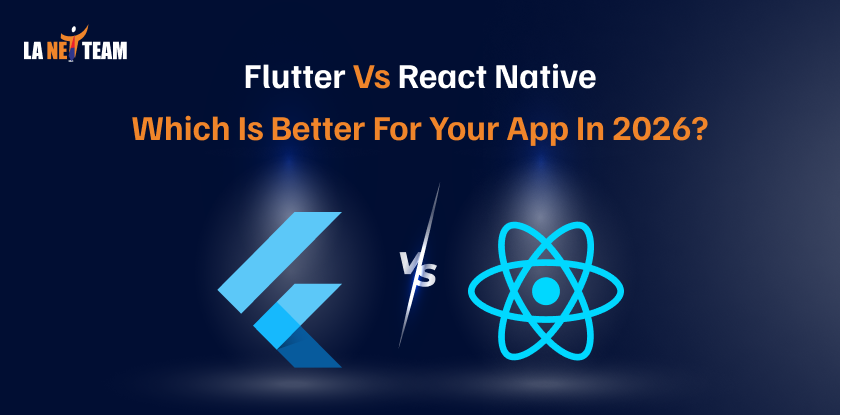Imagine you want to build one app that works on both iOS and Android phones.
BUT… no one would want to build it twice or spend double the money. That is where Flutter and React native help you. They let you write code ONCE and use it on both platforms.
Even Big brands such as Google, Tesla, & Instagram use this powerful framework.
But the real problem is…..
Many businesses still don’t know which framework is the best. And picking the WRONG one can make your app slow and difficult to maintain.
A recent survey shows that around 42 percent of users uninstall an app due to poor performance. Which often HAPPENS… due to the wrong framework. So, let’s find out which one fits your business best in 2026.
Understanding what is mobile app development and the different approaches available helps you make smarter technology choices for your project.
Flutter Vs React Native: The Real Difference
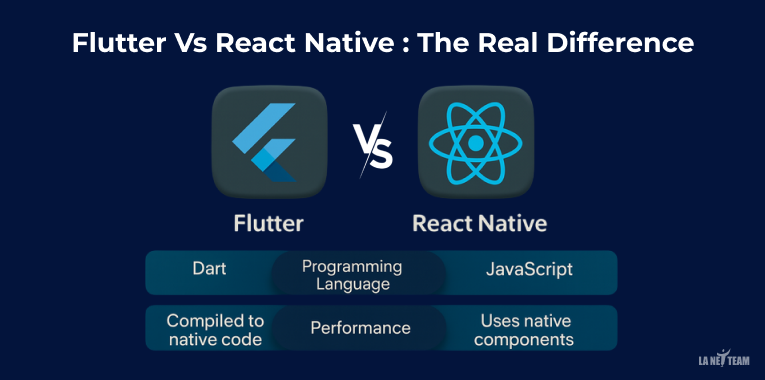
Both Flutter and React Native let you build apps for iOS and Android with one codebase. But they work differently under the hood.
Let’s break them down individually & what they actually mean for your project.
What is Flutter?
Flutter is a free, open-source framework created by Google in 2017. It uses a programming language called ‘DART’. Nobody would use Dart before Flutter, but now millions of developers have been adapting it.
By using Flutter, you can build apps that work across mobile, web, and desktop.
Did You Know : Big companies like Alibaba, Philips Hue, and Hamilton use Flutter for their apps.
Why Developers Love Flutter?
- The UI looks amazing:
Apps made with Flutter look really good. The animations are smooth, meaning everything moves and transitions without any awkward pauses. Imagine it by thinking about the difference between a simple, homemade website and an Apple product. By using the Flutter app, feel as sleek & professional as those high-end designs. - Apps run super fast:
Apps made with Flutter are super fast. As, its graphic engine is optimized to run at 60 frames per second. This means the app gets refreshed and updates its visuals 60 times per second. - Tons of ready-made widgets:
Widgets are the ready-made pieces you use to build your app. For example, if you need a button or menu, just use the corresponding widget. This is where Flutter gives you hundreds of these pieces, so you don’t have to make everything from scratch. - Great learning resources:
By using Flutter, you can learn easily with clear guides that explain to you how to use everything. Additionally, there is a large community of developers who are always ready to help. For example, if you run into a problem, just ask online, and you’ll get your answer quickly. - Looks the same everywhere:
No matter whether your app is on a new iPhone or an older Android, it will look exactly the same. Flutter is great for brands that want their app to have a uniform look, no matter what phone people are using.
The Downsides (Being honest here)
- Not Truly Native
Flutter apps are not fully ‘Native’. As they don’t rely on the phone’s built-in components for everything. Instead, Flutter makes its own interface and elements.
But for the apps where they need specific phone features, a fully native app might work better.
- App Files are bigger
A simple Flutter app might be 12MB to download, while a native app doing the same thing might be only 4MB.
For people on limited data plans or older phones with less storage, this matters. Though honestly, with modern phones having 128GB of storage, it’s not a huge deal.
What is React Native?
React Native is an open-source framework created by Facebook in 2015. It uses ‘JavaScript’ as the programming language that allows you to build the app on both iOS & Android using the same code.
This means that you don’t need to write separate code for both platforms.
Did You Know
Big companies like Skype, Instagram, and Uber Eats are built with React Native.
Why Developers Love React Native?
- Uses JavaScript:
React Native is based on JavaScript, one of the most popular and widely used programming languages.
Since many developers are already familiar with JavaScript, it’s easier for them to transition into mobile app development without learning an entirely new language.
- One codebase for multiple platforms:
With React native, you need to write the code once and use it on both iOS and Android.
This eliminates the need to write separate code for each platform, saving you time and resources.
- Promotes code reusability:
With React native, you can reuse parts of the code across projects.
This speeds up development because you don’t need to rewrite the same code for different parts of your app or for different projects.
- Active community:
There’s a large group of developers helping each other. Therefore, if you run into any issues, chances are someone has already faced and solved the same problem.
- Speeds up development:
React Native, with its huge collection of pre-built components and tools, helps you build apps faster.
The Downsides (Being honest here)
- Not fully native: It’s not the same as building a native app for each platform.
- Limited ready-made components: Doesn’t offer as many pre-built features compared to some other frameworks.
- Abandoned libraries: Some old tools may no longer be supported.
- UI can be tricky: It may require a lot of testing to ensure a smooth user interface.
- Bigger app sizes: React Native apps tend to be larger in size.
Flutter Vs React Native Cost Comparison: Where To Actually Spend?
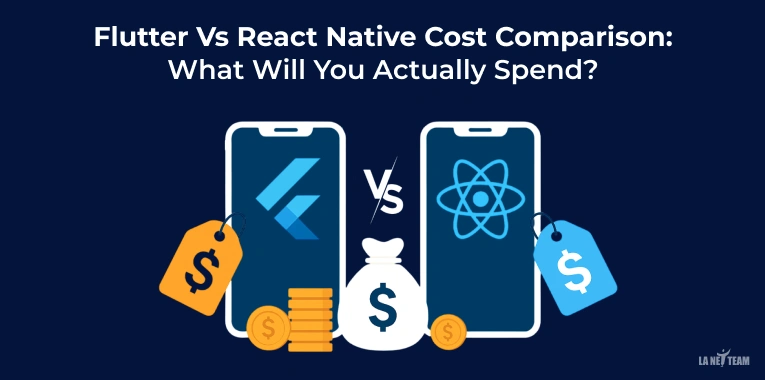
Understanding the complete Mobile App Development Process helps you budget accurately and plan realistic timelines for your cross-platform app, whether you choose Flutter or React Native.
When Building A Simple App
A simple app refers to an App with basic features, such as login, a few screens, and straightforward data.
| Framework | Cost | Time | Team |
|---|---|---|---|
| Native (iPhone + Android separately) | $80,000 -$150,000 | 6-8 months | 4-6 people |
| Flutter | $45,000 – $75,000 | 3-4 months | 2-3 people |
| React Native | $40,000 – $70,000 | 3-4 months | 2-3 people |
Bonus tip: Both Flutter and React Native cut costs by about 50% compared to building native apps separately.
When Building A Complex App
A complex app refers to an App that includes advanced features, a customized design, animations, backend servers, and a large amount of data.
| Framework | Cost | Time | Team |
|---|---|---|---|
| Native (iPhone + Android separately) | $200,000 – $500,000 | 12-18 months | 8-12 people |
| Flutter | $120,000 – $250,000 | 6-9 months | 4-6 people |
| React Native | $100,000 – $200,000 | 6-9 months | 4-6 people |
Yearly Maintenance Costs
Every app needs an update, bug fixes, and new features for new devices or OS versions. Usually, maintenance costs 20-25% of the initial development cost per year.
Let’s see the breakdown:
$50,000 Flutter app = $10,000 -$12,500/year
$50,000 React Native app = About the same
Flutter vs React Native: Which One Should You Choose?
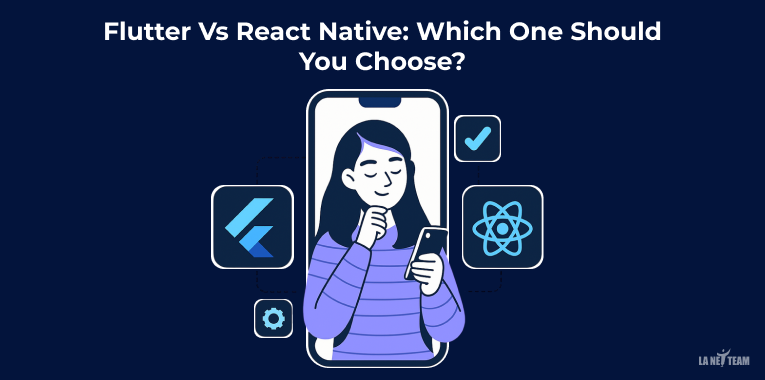
Choosing the right framework for building your mobile app can be a tough decision.
Both Flutter and React Native are popular, open-source frameworks that let you build apps for both iOS App development and Android with a single codebase.
But which one is best for your project? Let’s break it down.
Choose Flutter if-
1. You care about design perfection
Your brand identity is super important. You need your exact colors, your exact spacing, your exact everything on every device. Flutter gives you total control.
Design agencies love Flutter because they can make apps look exactly like their mockups with zero compromises.
2. You want smooth Animations
Building a fitness app with animated workouts? A kids’ education app with bouncing characters? A meditation app with flowing visuals? Flutter’s graphics engine makes animations buttery smooth.
3. You are building for multiple platforms
Flutter doesn’t just do iPhone and Android app development. It also works on:
- Windows computers
- Mac computers
- Linux computers
- Web browsers
- Even smart TVs and car displays
If you need your app on more than just phones, Flutter supports way more platforms out of the box. One codebase literally runs on 6+ different platform types. If you’re also considering browser-based solutions, explore Web Application Development to complement your mobile strategy effectively.
4. You need long-term stability
Google uses Flutter for its own products. They’re heavily invested in making it better. Flutter is not going anywhere. It’s going to be supported and improved for many years.
Google has stated Flutter is a core part of their strategy, and they have hundreds of engineers working on it full-time.
5. Your team is starting fresh
If you’re hiring new developers anyway, Dart is actually easier to learn than JavaScript. It’s cleaner and simpler. Your team will be productive faster.
Choose React Native if-
1. When your team already knows JavaScript
Why learn a new language if you don’t have to? If your developers already build websites with React, they can start building mobile apps tomorrow with React Native.
One startup reported going from zero to published app in 6 weeks because their web team could reuse their skills.
2. You need Native Feel
Building for both platforms, but want each to feel perfectly at home? React Native apps feel like real iPhone apps on iPhones and real Android apps on Android.
Users often can’t tell the difference between React Native apps and fully native apps.
3. You have a TIght budget and timeline
React Native’s massive ecosystem of pre-built components means you don’t build everything from scratch. Need a map? There’s a package. Need payments? There’s a package. Need camera features? Package.
Flutter’s ecosystem is growing fast, but React Native still has more ready-to-use packages because it’s been around 3 years longer.
4. You need specific Native features
Sometimes you need really specific phone features. React Native’s longer history means better support for weird edge cases. Need to integrate with that one specific Bluetooth device? Someone probably already solved it in React Native.
Real World Apps: Who’s Using Flutter & React Native?
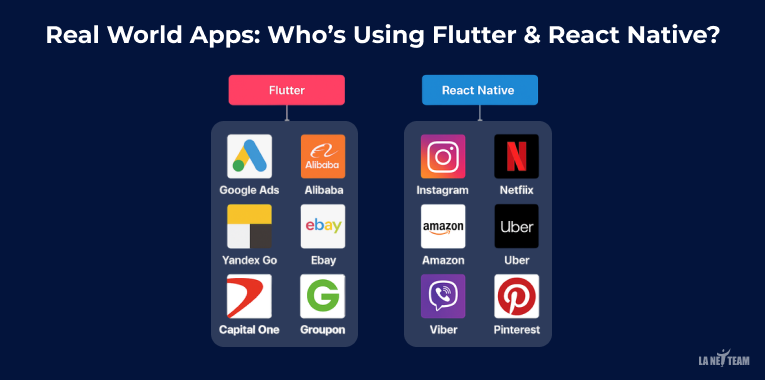
Let’s look at the apps you actually use every day.
Flutter
- Used by Google Pay, Alibaba, BMW, and Tonal
- It is popularly known for its smooth animations, consistent UI, and cross-platform support.
- Over 500,000 apps use Flutter as of 2025.
React Native
- Used by Facebook, Tesla, Shopify, Discord
- It is popularly known for its speed of development and handling large-scale apps.
- Over 700,000 apps use React Native as of 2025.
Wrapping Up
It comes down to what you need. If you want a perfect design, smooth animations, and support across multiple platforms, go with Flutter. It’s great for apps that need consistency everywhere.
If your team knows JavaScript and you need faster development with loads of pre-built tools, React Native is your best bet. It’s solid for high-performance apps that feel native.
Both are solid choices, so pick based on your project’s needs, timeline, and features. Either way, you’re set for the future of mobile development.
